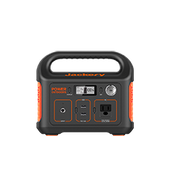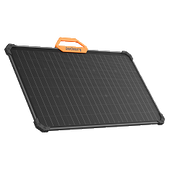Like any other appliance, your car’s air conditioning system has an expiry date. Instead of replacing or purchasing a new AC, it is worth understanding how to charge a car AC system if the built-in AC stops cooling. Electric issues, mold buildup, a leak in the refrigerant, and a faulty compressor are just a few reasons this can happen.
If you are headed out in the summer months, driving in the heat with a faulty car AC system can be unbearable. Jackery Solar Generators are reliable solar-powered generators that can charge portable cooling equipment such as portable ACs or fans in the vehicle. They are compact in size, feature a sturdy handle, and do not emit any toxic fumes when charging the appliances.
Key Takeaways
Like any device or appliance, a car’s AC unit can have minimized cooling due to damage or leaks in the refrigerant.
- It is essential to understand the specifications of your car, like the refrigerant type, how a compressor works, and the difference between other components.
- You need to identify the type of AC refrigerant used in your car to proceed to recharge it.
- You can manually recharge your car’s AC unit or use an alternative device like a portable generator.
- Choose easy tips to keep your car cool naturally, such as parking under a shade, getting reflective tinted windows, and covering your dashboard with a towel.
How Does A Car AC System Work
A car’s AC system works in the same manner as your home’s air conditioning system. It follows the principle of heat exchange, with the refrigerant absorbing or releasing heat. If the cooling lessens over time, you must get the refrigerant inspected.
The Heart Of The Unit: The Compressor
The compressor is the central unit of your car’s AC system. It stores the refrigerant gas and transforms it into a liquid state. This liquid is passed through condenser tubes in the AC, which further comes in contact with fresh air.
The Functioning Of The Refrigerant
The amount of refrigerant ensures the intensity of cool air in your car when you turn the AC on. Once it reaches the accumulator, moisture is removed, making the refrigerant cooler. It travels from the orifice tube to the evaporator, transforming the heat outside into cold air blowing in the car.
When you switch on your car’s AC system, cold air is released from the vents, making the temperature inside cooler and drier. This process makes the refrigerant liquid hotter in the system. It converts back into a gaseous state and flows into the compressor. The cycle repeats itself as long as the AC system is turned on.
Understanding A Car AC System’s Specifications
To understand how to charge the AC system in your car, you need to know about its different components and how they work. These basics can help you understand how your car converts the hot air outside to provide the cooling you desire inside.
Compressor
The compressor is a car’s main AC system unit and powers the refrigerant. It separates low-pressure and high-pressure air, maintaining the temperature inside a car by converting the air from the outside. It is located in the front of the engine and is run by the serpentine belt.
Condenser
When the pressure in the AC system changes, the condenser helps maintain high pressure while reducing the temperature of the refrigerant. It converts the refrigerant gas into a liquid and transfers heat using forced air.
Dryer
The dryer consists of a drying agent that separates water from the refrigerant. It can be located between the condenser and the metering device on the high-pressure side of the unit.
Evaporator
The evaporator transforms the refrigerant liquid back into its gaseous state, releasing cold air into the car. It is located right behind the dashboard and uses the fan next to the passenger seat to exchange heat and provide consistent cooling.
Orifice Tube
Also known as a metering device, the orifice tube maintains the refrigerant pressure in the car’s AC unit. It changes the refrigerant mist from high to low pressure, further flowing into the evaporator.
Refrigerant
The R134a refrigerant is the industry standard for automotive AC systems. Its thermodynamic properties are less impactful on the depletion of the ozone layer. It consists of low and high side pressures, which convert the refrigerant liquid to a gaseous state and back into liquid form.
An AC Pressure Chart can be utilized to check both sides of a refrigerant's pressure. It is a testing device with pressure gauges—red for the high-side pressure gauge and blue for the low-side pressure gauge. To understand how to charge the car AC system, read the following table, which shows different pressure sides of a refrigerant at given temperatures.
|
R-134a Temperature Pressure Chart |
||
|
Ambient Temperature °F/°C |
Low-Pressure Gauge |
High-Pressure Gauge |
|
65°F (18°C) |
25 - 35 psi / 172 - 241 kPa |
135 - 155 psi / 931 - 1069 kPa |
|
70°F (21°C) |
35 - 40 psi / 241 - 276 kPa |
145 - 160 psi / 1000 - 1103 kPa |
|
75°F (24°C) |
35 - 45 psi / 241 - 310 kPa |
150 - 170 psi / 1034 - 1172 kPa |
|
80°F (27°C) |
40 - 50 psi / 276 - 345 kPa |
175 - 210 psi / 1207 - 1448 kPa |
|
85°F (29°C) |
45 - 55 psi / 310 - 379 kPa |
225 - 250 psi / 1551 - 1724 kPa |
|
90°F (32°C) |
45 - 55 psi / 310 - 379 kPa |
250 - 270 psi / 1724 - 1862 kPa |
|
95°F (35°C) |
45 - 55 psi / 310 - 379 kPa |
275 - 300 psi / 1896 - 2068 kPa |
|
100°F (38°C) |
45 - 55 psi / 310 - 379 kPa |
315 - 325 psi / 2172 - 2241 kPa |
|
105°F (41°C) |
45 - 55 psi / 310 - 379 kPa |
330 - 335 psi / 2275 - 2310 kPa |
|
110°F (43°C) |
45 - 55 psi / 310 - 379 kPa |
340 - 345 psi / 2344 - 2379 kPa |
|
Ambient temperature is the outside atmospheric temperature. |
||
Preparations For Charging Your Car’s AC System
Consider some essential steps to understand how to charge a car’s AC system effectively. This also includes having equipment that will help restore your car’s cooling.
Step 1: Consult The Owner’s Manual
The first step in charging your car's AC system is to check the automotive manual issued by your car company. The handbook contains information on your refrigerant’s cooling capacity, the type of refrigerant used, and step-by-step instructions for easily fixing the cooling issue.
Step 2: Check The Service Port Couplers
The service port couplers, situated under your car's hood, indicate what type of refrigerant is used in it. The R134a system is the universal refrigerant type with threaded service ports. It has blue or black dust caps. You will find a smaller system if you use a different type of refrigerant.
Step 3: Look For Labeling
The best way to understand the type of refrigerant used in your car’s AC system is to check out the label. It is pasted under the hood and clearly demarcates whether the refrigerant is R134a or R1234YF.
Step 4: Professional Assistance
Despite trying the above-mentioned steps, if you cannot determine the type of refrigerant used in your car, seek professional help. Contact a certified technician to accurately determine the type of refrigerant and charge your car’s AC system.
You will also need the following list of equipment before charging the AC unit:
- Refrigerant type
- Safety glasses and gloves
- Refrigerant dispenser with a charging hose
- Owner’s handbook
- UV kit
How To Charge A Car AC System
Charging your car’s AC involves a step-by-step process, starting with turning off your car. Identify the type of refrigerant used in your car’s model and follow the guidelines below for a successful recharge.
Step 1: Repairing The Leaks
Check the car’s refrigerant for leaks. Leaks are the most common cause of minimizing the car’s cooling capacity.
- Create a mixture of dish soap and tap water.
- Pour the solution into a spray bottle and coat the AC component to find leaks.
- The area with a leak will have bubbles forming around it.
- If you see big bubbles and a lot of foaming, your car’s AC system has a major leak.
For big leaks, contact a professional. For smaller leaks, use these steps or purchase a leak detector kit. These kits contain sealants that can easily cover small leaks.
Step 2: Checking The Pressure
Before gauging the pressure of your car’s AC unit, wear protective glasses and gloves. If you do not handle refrigerants safely, they can lead to mishaps like frostbite and partial or total blindness.
Check your car’s AC system for the high- and low-pressure ports. Locate the tubes by following the labels on them. H stands for high pressure, and L stands for low pressure. If the labels aren’t mentioned, you can identify the ports yourself. The low-pressure port is comparatively larger than the high-pressure port.
- Unscrew the port cap and keep it safe.
- Connect the gauge hose to the port.
- Read the pressure gauge, which is available in a colored scheme. Green stands for good.
- If the gauge indicates the pressure is above 0, you can proceed with recharging your AC system.
Step 3: Testing Your System
Now that you have checked the pressure on your refrigerant, turn on the car and test the AC unit.
- Turn on the AC to its maximum temperature.
- Keep the hood of your car up.
- Check if the compressor clutch is spinning. If it doesn’t spin, add a small refrigerant bottle to check again.
- As the component recharges, set the temperature gauge to the ambient temperature.
- Ensure the refrigerant temperature gauge stays in the white or green zone, not red.
- Turn off your car.
If the gauge shows a reading that falls into the red zone, contact a technician for further assistance.
Step 4: Adding The Refrigerant
Remove the inner cap by unscrewing the trigger once it is ready to use the refrigerant. Then pierce the top by screwing the cap back on. If you hear a hissing sound, put the refrigerant in your car.
- Shake the refrigerant can to ensure that all ingredients are mixed thoroughly.
- Attach it to the low-pressure line port.
- Squeeze the refrigerant trigger by putting pressure on the cap. This allows it to flow into your car’s AC system.
- Check the pressure after a few seconds to ensure there’s not too much refrigerant in your car.
Step 5: Finishing The Recharge
After filling your car's AC system with the desired refrigerant amount, remove the can from the port, add the port cap back on, and test your AC to ensure it's cooling properly.
If your car’s AC system fails to blow out cold air, consult a professional for the best possible solution.

Alternative to Charge Car AC with Jackery
Solar generators are eco-friendly charging solutions that can charge portable car ACs in remote locations. Jackery is a leading solar brand that's known for manufacturing highly efficient solar generators, solar panels, and portable power stations. The Jackery Solar Generators combine the foldable Jackery SolarSaga Solar Panels and highly efficient Jackery Portable Power Stations to supply steady power to outdoor appliances.
The Jackery Solar Generators are portable enough to be carried in a car to charge appliances on the go. For instance, you can charge portable ACs or fans to keep the vehicle cool in the summer or lights to illuminate the space at night. You can place the portable solar panels under direct sunlight to convert the sun's energy to DC electricity. The pure sine wave inverter of the Jackery Portable Power Stations will then convert DC to AC electricity.
Jackery Solar Generator 3000 Pro
The Jackery Solar Generator 3000 Pro is a large solar-powered generator that can charge 99% of indoor or outdoor appliances. The ergonomic design and foldable handle ensure you can easily move the generator in and out of the vehicle. It’s also capable of charging different types and sizes of portable ACs and fans to keep the interior cool in the hot summer. It's ideal for outdoor car camping trips where you might need to charge multiple appliances for hours.
Appliances Running Time
- Portable AC (700W) = 3.6H
- Car Fridge (60W) = 42.8H
- Portable Fan (50W) = 51.4H
- Camping Lights (20W) = 128.5H
- Air Cooler (150W) = 17.1H

Customer Review
“All I can say is it ran in my refrigerator for 12 hours and only got down to 60%. That’s without solar panels. Also ran my PC (lots of social media videos), Xbox, and fan on another day, and it got down to 12%. Pretty impressed.” — Rhys Adams.
Jackery Solar Generator 2000 Plus
The Jackery Solar Generator 2000 Plus is another large and expandable capacity solar-powered generator that can power 99% of indoor or outdoor appliances. You can carry the solar generator while camping or overlanding to charge cooling appliances such as portable fans or ACs. If you ever think you need more power, you can expand the capacity from 2kWh to 24kWh with additional battery packs.
Appliances Running Time
- Portable AC (700W) = 2.4H
- Car Fridge (60W) = 28.9H
- Portable Fan (50W) = 34.7H
- Camping Lights (20W) = 86.8H
- Air Cooler (150W) = 11.5H

Customer Review
“I went off grid with it and we love it. We live in a camper and power up everything for at least 2 days without charging but using everything so I'm very happy.” — Marcin Powichrowski.
Jackery Solar Generator 2000 Plus Kit (4kWh)
The Jackery Solar Generator 2000 Plus Kit (4kWh) also has a large battery capacity and portable design to combine functionality and portability in one. You can power most indoor or outdoor appliances anytime you want. The portable power station has a sturdy handle and double wheels for easy movement from one place to another. If you plan an extended car camping trip, the Jackery Solar Generator 2000 Plus Kit (4kWh) can charge 99% of your camping appliances.
Appliances Running Time
- Portable AC (700W) = 4.9H
- Car Fridge (60W) = 57.8H
- Portable Fan (50W) = 69.4H
- Camping Lights (20W) = 173.6H
- Air Cooler (150W) = 23.1H

Customer Review
“The Jackery Explorer 2000 Plus and Battery Pack with the solar panels package is a great combination for home backup and RV usage. The 120VAC and RV receptacles and the others are great to have on the unit.” — Larry Gee.
How To Keep Your Car Cool
Your car’s AC system can be recharged systematically and also by using portable generators. Additionally, you can consider some natural ways of keeping the temperature inside your car cool for longer.
Park Your Car Under A Shade
Always park your car under a shaded area, like a closed or covered parking lot. You can also find covered spaces under a tree to maintain your car’s temperature. This helps reduce the heat on the car’s metal, obstructing heat transmission into the inside of the vehicle.
Cover The Dashboard
You can use a towel to cover your car's dashboard during the wee hours of the day. Since the dashboard is made of plastic, it can heat up quickly, causing the insides of a car to become hot. The towel can have an insulating effect, reducing the heat on the dashboard.
Tint Your Car Windows
Install reflective tinted glasses on your car windows to maintain a cooler temperature. This will also give passengers privacy while protecting them from the sun's glare.
FAQs
What size generator do I need for my AC?
The size of the generator will directly depend on the wattage of the AC and the total number of hours you want to run it. Let's say you're planning an extended car camping trip and want to use an AC (700W) and camping lights (20W) simultaneously. If you use the Jackery Solar Generator 2000 Plus to charge these appliances, the running time of the solar-powered generator can be calculated as follows:
Working Hours = Battery Capacity in Wh × 0.85 ÷ Operating Wattage of the Appliances = 2042.8Wh × 0.85 ÷ 720W = 2.4H
Note: Since there will be some power loss when charging the appliances, we have multiplied the battery capacity by 0.85.
How much does it cost to recharge an AC car?
If you seek professional help to charge your car’s AC system, you can expect to spend around $150-$300. However, depending on the make and model of your car, there might be additional costs. If you use a portable generator to recharge it instead, you will only have to spend a one-time cost on purchasing the device. The cost of the device will depend on the brand and model.
Can I recharge my car AC myself?
Yes, you can recharge your car’s AC if you know the refrigerant used in your vehicle. Since the cooling is less, you must fix the refrigerant leak. Proceed to check the pressure of your AC unit and test your system. Once successful, add the refrigerant to complete the process.
How do I know if my car AC needs to be charged?
If your car’s AC system blows out less cold air or does not work when you switch it on, you will need to recharge the unit. Check the refrigerant pressure. If it is above 0, it will need to be charged.
Do you turn off the car to recharge the AC?
Yes, you must turn off your car before recharging your AC unit. Once you add the refrigerant after conducting the necessary steps, turn on the car and switch on your AC to its maximum temperature. This will help you understand if the process is successful or not.
Final Thoughts
Whether you are new to or experienced in handling automobiles, it is imperative to understand how to charge your car's AC system safely and effectively. Conduct your due diligence to understand how a car's AC system works, its key specifications, safety tools and guidelines, and other alternatives you can consider. Remember, your car's longevity depends on how you upkeep it.
If you're planning a road trip or a car camping in a remote location, you'll need a reliable solar-powered generator that can charge most of your outdoor appliances. The Jackery Solar Generators can power most low to high-power essential appliances, such as portable ACs and fans, to keep the car interior cool during road trips.
When was the last time you planned a car camping trip? And how do you keep the car cool in the hot summer months? Let us know in the comments below!




















































































































Leave a comment